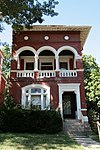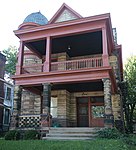Church of the Annunciation, Cincinnati
Ohio church stubsRoman Catholic churches in CincinnatiUnited States Roman Catholic church stubs

The Church of the Annunciation is located at 3547 Clifton Avenue at Resor Street in Cincinnati, Ohio, United States. The Church is located in the Clifton neighborhood. It is part of the Clifton Avenue Historic District. This historic parish was founded in February 1910, and the present building was completed in August 1930. This church was designed by Boston architect Edward T. P. Graham, who was active in both the Archdiocese of Boston and the Archdiocese of Cincinnati in the first half of the 20th century.
Excerpt from the Wikipedia article Church of the Annunciation, Cincinnati (License: CC BY-SA 3.0, Authors, Images).Church of the Annunciation, Cincinnati
Resor Avenue, Cincinnati Clifton
Geographical coordinates (GPS) Address Nearby Places Show on map
Geographical coordinates (GPS)
| Latitude | Longitude |
|---|---|
| N 39.147222222222 ° | E -84.519444444444 ° |
Address
Church and School of the Annunciation
Resor Avenue
45220 Cincinnati, Clifton
Ohio, United States
Open on Google Maps











